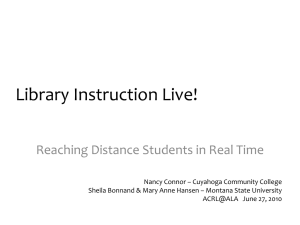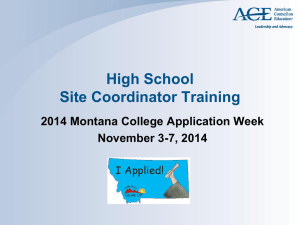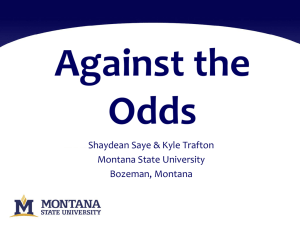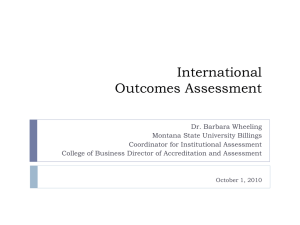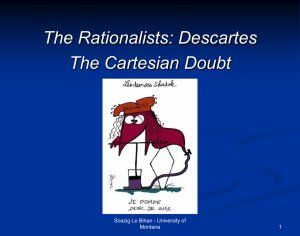Navigating Summary Judgment Takings Lessons
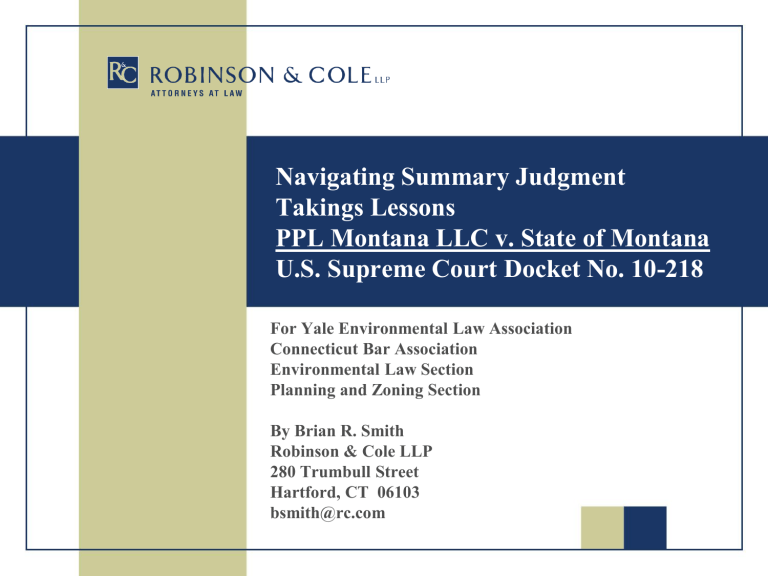
Navigating Summary Judgment
Takings Lessons
PPL Montana LLC v. State of Montana
U.S. Supreme Court Docket No. 10-218
For Yale Environmental Law Association
Connecticut Bar Association
Environmental Law Section
Planning and Zoning Section
By Brian R. Smith
Robinson & Cole LLP
280 Trumbull Street
Hartford, CT 06103 bsmith@rc.com
The Issue
Navigability for title as to more than 500 miles of river including the riverbed under multiple hydropower facilities.
The state of Montana asserts “[f]rom territorial times to this day the Great Falls of the Missouri have appeared on the official seal of Montana.”
Respondent’s brief at 1.
The Question
For title purposes, what should be examined at trial, the whole river or relevant sections?
Typically, a title dispute is resolved in the highest court of a state and there is no federal question.
But, whether a river is navigable for title purposes
“is necessarily a question of federal law.” United
States v. Holt State Bank, 270 U.S. 49, 55-56 (1926).
From a takings perspective, the question here is whether the Montana Supreme Court using the
Equal Footings Doctrine “allowed the State to exploit supposed ambiguities in the doctrine of title navigability to effectuate a massive land grab.”
Petitioner’s Brief at 25.
Montana responds by noting, PPL “decries the
Montana Supreme Court’s decision as a judicial taking.” Respondent’s Brief at 3.
Montana asserts that PPL is the one doing the taking “by asking this Court to substantially narrow the centuries old concept of navigability and thereby deprive Montana – [ ] of [ ] long-held title to the riverbeds at issue.” Id.
Judicial Takings
PPL alleges that Montana unilaterally and retroactively took lands by revising the history of what happened in 1889 when Montana entered the
Union.
A state court can be accused of a judicial taking.
See Stop the Beach Renourishment, Inc. v. Fla.
Dep’t. of Envtl. Prot., 130 S. Ct. 2592, 2601 (2010)
(plurality opinion).
The Montana Supreme Court affirmed the trial court’s grant of summary judgment. It considered
de novo the evidence presented by the parties that was in the form of affidavits and deposition testimony.
PPL relies on United States v. Utah, 283 U.S. 64
(1931) for its section by section claim.
The Montana Supreme Court majority rejected
PPL’s analysis stating that Utah is distinguishable because the sections in question in Montana are relatively short and would not defeat a determination of navigability of an entire river.
Montana’s Justice Rice dissented asserting that the majority “erred in its analysis of the law governing title navigability and also failed to properly apply the tenets of summary judgment by disregarding genuine material factual conflicts.”
A short section, according to the Montana Supreme
Court, is 17 miles long.
In Utah, a 4.35-mile section was found nonnavigable after special master’s fact finding.
Summary judgment may only be granted when there are no genuine issues of material fact and as a matter of law only when one outcome is indicated.
This case turns on what is meant by long or short sections of a river and whether the five hundred pages of documentary and expert testimony presented by PPL is enough to defeat a motion for summary judgment.
Curiously, PPL did admit to navigability of the rivers in prior federal proceedings but was not held to account for these admissions by the Montana
Supreme Court.
On the other hand, the Montana Supreme Court discounts a 1930s Army Corps of Engineers report as conclusory although it was more contemporaneous with state of the rivers in 1889.
“It is settled that historical works generally considered authentic are admissible in evidence especially in cases such as this one which must delve into relatively obscure origins of commerce on the nation’s rivers.” Conn. Light & Power Co. v.
Federal Power Comm’n, 557 F.2d 349, 354-356
(2d Cir. 1977).
By affirming the granting of summary judgment, the Montana Supreme Court has exposed itself to a judicial takings claim first articulated in Stop the
Beach Nourishment.
Likely Outcome (No Guarantees)
Justice Rice notes that the majority “does not explain why a non-navigable stretch running from
Fort Benton to Great Falls is too ‘short’ and how it can so declare as a ‘matter of law’ without fact finding.”
The U.S. Supreme Court will likely reverse and remand for precisely this type of fact-finding to skirt the judicial takings issue.






